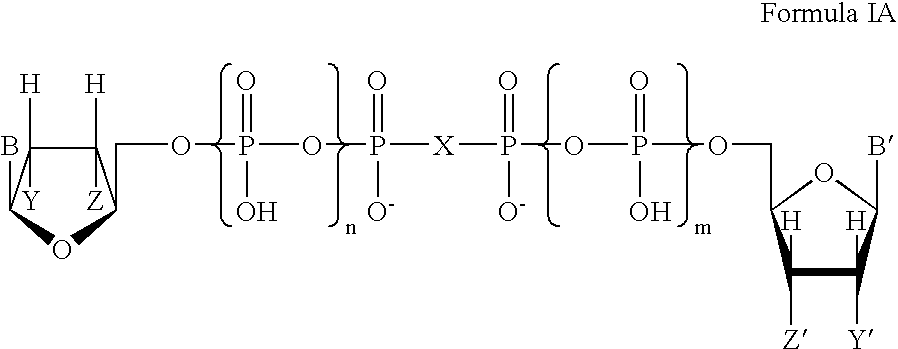Certain dinucleotides and their use as modulators of mucociliary clearance and ciliary beat frequency
a technology of dinucleotides and mucociliary beats, applied in the field of dinucleotides and their use as modulators of mucociliary clearance and ciliary beat frequency, can solve the problems of significant morbidity and mortality, patients who are immobilized for a variety of reasons are at high risk of developing pneumonia, and hearing impairment and potential language and cognitive development delays, so as to facilitate sputum induction procedures and increase the clearance of mucous secretions
- Summary
- Abstract
- Description
- Claims
- Application Information
AI Technical Summary
Benefits of technology
Problems solved by technology
Method used
Image
Examples
example 1
Preparation of P1,P4-Di(uridine 5′-)P2,P3-methylenetetraphosphate
[0105]Methylenediphosphonic acid (Aldrich, 0.0088 g, 0.05 mmol) was dissolved in anhydrous DMF (0.5 mL) with the addition of tributylamine (24 μL, 0.1 mmol). The solution was evaporated to dryness twice with anhydrous DMF (2×1 mL), the dried residue dissolved in anhydrous DMF (0.5 mL), and a solution of similarly-dried uridine 5′-monophosphomorpholidate 4-morpholine-N,N′-dicyclohexylcarboxamidine salt (Sigma, 0.137 g, 0.2 mmol) in anhydrous DMF (0.5 mL) added. The reaction mixture was heated at 80-90° C. for 7 h; then the solvent was removed by evaporation under reduced pressure. The residue was dissolved in water (2 mL) and applied to a column of DEAE cellulose (2.5×50 cm bed volume) in the bicarbonate form. The column was eluted with water, followed by a gradient of ammonium bicarbonate (0-0.33 M, in 900 mL). The progress of the elution was followed by monitoring absorbance of the eluate at 254 nm; the fraction eluti...
example 2
Preparation of P1,P4-Di(uridine 5′-P2,P3-difluoromethylenetetraphosphate)
[0106]The tributylammonium salt of difluoromethylenediphosphonic acid (as described in C. McKenna, et al., J. Org. Chem. 46, 4574-76 (1981) and D. Burton, et al., J. Fluorine Chem. 15, 263-66 (1980)) (0.014 g, 0.025 mmol), converted to the salt as described for methylenephosphonic acid was dissolved in a solution of uridine 5′-monophosphomorpholidate 4-morpholine-N,N′-dicyclohexylcarboxamidine salt (Sigma, 0.034 g, 0.05 mmol) in anhydrous dimethyl sulfoxide (0.7 mL), and heated for 9 days at 50° C. The cooled reaction mixture was diluted with water and applied to a column of DEAE cellulose (2.5×50 cm bed volume) in the bicarbonate form. The column was eluted with water, followed by a gradient of ammonium bicarbonate (0-0.33 M, total volume 900 mL). The progress of the elution was followed by monitoring absorbance of the eluate at 254 nm. The fraction eluting between 0.29 and 0.30 M was evaporated to dryness and...
example 3
Preparation of P1,P4-Di(uridine 5′-P2,P3-imidotetraphosphate)
[0107]Tetrasodium imidodiphosphate (Sigma, 0.05 mmol) was dissolved in water 0.5 mL) and applied to a column of Biorad AG-MP50 strong cation exchange resin (2 mL bed volume, 3 meq) in its tributylamine form. The column was eluted with water (˜10 mL), the eluate lyophilized dried by evaporation with dry DMF. Treatment of uridine 5′-monophosphomorpholidate 4-morpholine-N,N′-dicyclohexylcarboxamidine salt (Sigma, 0.068 g, 0.1 mmol) with a solution of the tetrabutylammonium imidodiphosphate (0.05 mmol) in anhydrous DMF (1.0 mL) for 20 days at room temperature, and isolation essentially as described above yielded the title compound as the ammonium salt (1.6%). 1H NMR in D2O (δ ppm from tetramethylsilane): 4.07-4.09 (m, 6H); 4.17-4.22 (m, 4H); 5.79 (d, J=8.1 Hz, 2H); 5.80 (d, J=4.8 Hz, 2H); 7.78, d, J=8.2 Hz, 2H). 31P NMR in D2O (δ ppm from H3PO4) −10.82 (m, 4P); P-P coupling pattern similar to that of P1,P4-di(adenosine 5′-tetr...
PUM
| Property | Measurement | Unit |
|---|---|---|
| total volume | aaaaa | aaaaa |
| bed volume | aaaaa | aaaaa |
| bed volume | aaaaa | aaaaa |
Abstract
Description
Claims
Application Information
 Login to View More
Login to View More - R&D
- Intellectual Property
- Life Sciences
- Materials
- Tech Scout
- Unparalleled Data Quality
- Higher Quality Content
- 60% Fewer Hallucinations
Browse by: Latest US Patents, China's latest patents, Technical Efficacy Thesaurus, Application Domain, Technology Topic, Popular Technical Reports.
© 2025 PatSnap. All rights reserved.Legal|Privacy policy|Modern Slavery Act Transparency Statement|Sitemap|About US| Contact US: help@patsnap.com



